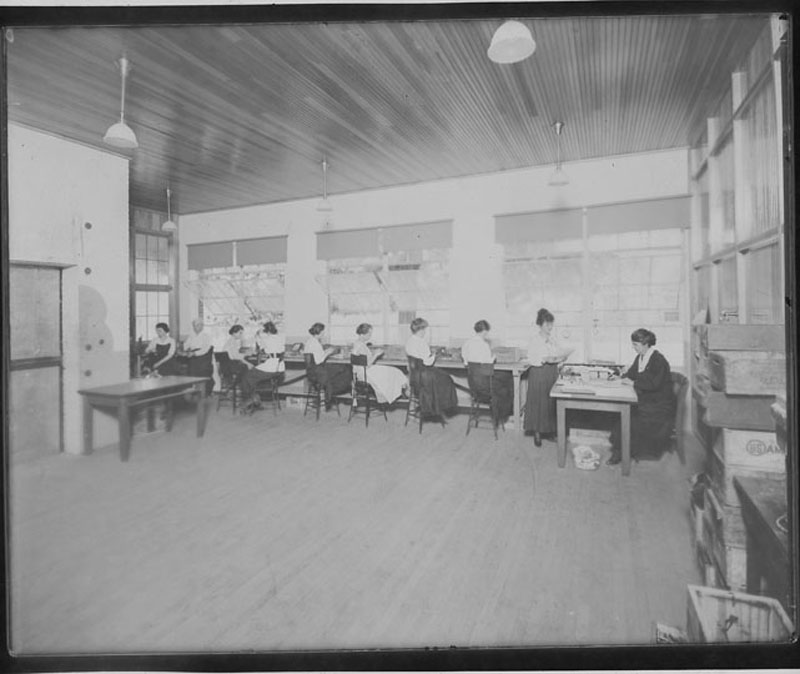.jpg)
Part time woman worker from WWII
During WWI and WWII, there were labor shortages that had to be filled
in order to supply soldiers on the frontline with guns, ammunition, and other
necessities. To fill the void, armories around the United States hired women.
This national trend can be observed in Springfield, Massachusetts. During both
wars, the Armory’s women workers proved vital to the war efforts. Without
these women’s contributions, the wars could have been lost. Despite these
contributions, many women did not always receive the credit they deserved.

Women Hand-Loading Machine Gun Belts, 1918
(Experimental Ammunition - Belt Loading Room)
In both wars, the need for male soldiers resulted in massive worker shortages.
Armories looked to women to fill the void left by the enlistees. In 1918,
there had been 748 women working at the armory.1 It
took at least six to twenty workers to adequately equip an American soldier and
women had been needed to fill the gap.2
Women workers became even more important to the war effort in World War II. Over
40 % of 13,500 Armory employees were female.3 These
women helped to manufacture the M-1 rifles that were used on D-day. In July of
1943, these women helped to output over 2,100 rifles a day, in order to maintain
the quotas given by the United States War Department.4
In addition to their role as producers for the War Effort, the women of the Springfield
Armory also represented a source of morale for the “boys” overseas.
For example, at the armory women employed in the payroll department created a
message published in the Armorer, the Armory newspaper, entitled “Don’t
Lose A Day.” 5 It
encouraged the soldiers to report each day and reaffirmed the women’s confidence
in the soldiers to do their ‘bit.’

Woman worker training to use the milling machine
The Armory also worked to boost the women’s morale while working at the
Armory. The Springfield Armory hosted several dances after drills for the Second
Infantry . The
Armory also held many football games, which allowed for a large gathering of6
officers and guests as well.7 These
events helped sustain the morale of soliders and workers alike.
At the end of both World Wars, women became the first to be given notice
of discharge. After World War I, approximately 1,000 employees had been fired
in January of 1919.8 Basically,
most women had been fired at the end of both wars to make way for returning soldiers.9 However,
some women did not want to return to their to more traditional roles of homemaker
and mother. Some of these women used their job experience working at the Armory
to obtain other positions, challenging the convention that women were not able
to work in the defense industry. 10These
women leave a tremendous legacy.
1 Springfield
Armory. National Park Service. University of Massachusetts. Oct. 27, 2006
Women in World War I.
4 Anderson,
Margaret. Employment of women in the
manufacture of cannon and small arms in 1942
. Washington, D.C. : U.S. Government Printing Office, 1943.
5 Armorer.
January 1918, vol. 1 no 2: p.1-14.
6 Hartley,
Harry. “Second Infantry, M.V.M.” Boston Daily Globe. March
12, 1917: p. 7.
7“Armory
Crushed by Boston Coast Defense Team 51 to 3.” Boston Daily Globe.
Nov 15, 1920: p. 11.
8 “Springfield
Armory to Discharge 500 Today.” Boston Daily Globe. Jan. 14, 1919:
p. 5.
9 “Springfield
Armory to Discharge 500 Today.” Boston Daily Globe. Jan. 14, 1919:
p. 5.
10 Foner,
Phillip. Women and the American Labor Movement. New York: Machmillan Publishing
Co, 1980.
11Foner,
Phillip. Women and the American Labor Movement. New York: Machmillan Publishing
Co, 1980.
|